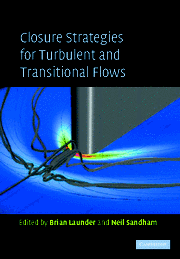23 - Use of Higher Moments to Construct PDFs in Stratified Flows
Published online by Cambridge University Press: 06 July 2010
Summary
Introduction
The distributions of moments calculated using turbulence models of different closure levels contain information about the statistical structure of turbulent fluctuations. This information is sufficient for a wide range of practical problems. However, as was noted in [15], for a complete statistical description of the flow-field characteristics of a turbulent flow one should define all the multidimensional joint probability distributions for values of these characteristics at every possible ensemble of points in space and time. The active use of this approach (the use of PDFs in the study of turbulence) began with the work of Monin (1967) and Lundgren (1967). These papers include the set of equations for the PDF of a random velocity field for developed turbulence. The advantage of using the PDF method for studying turbulence begins with the fact that every PDF from the family of finite-dimensional PDFs of the velocity field contains information about the whole associated system of statistical moments. However, the set of equations for the PDFs of the turbulence field is not closed. The complexity of solving this problem can be judged by noting that a closed form equation for the one-point joint PDF for developed inhomogeneous turbulence can only be obtained by applying additional hypotheses and the one-point joint PDF is itself multi-dimensional in character. In the papers of Lundgren (1967) and Onufriev (1970, 1977b) the model equations for the one-point PDF of the velocity and scalar fields have been derived on the basis of a number of phenomenological assumptions. Use of these equations opens the possibility of extending the semi-empirical methods for turbulent transfer, Onufriev (1977a). One can find an example of the numerical simulation of turbulent diffusion processes through the application of the model of Onufriev (1977b) for the one-point PDF in the paper by Belotserkovskii (1987) and the use of the PDF method for describing turbulent diffusion of a scalar in Pope (1980, 1983). Numerical integration of the model equation for the PDF usually requires powerful computer facilities and is rather expensive. However, the inherent advantages of the PDF method lead the writer to foresee the extensive use of this approach for studying the structure of turbulent flows in the near future. In this chapter another useful aspect of the use of the PDF for representing the turbulent transport structure will be considered.
- Type
- Chapter
- Information
- Closure Strategies for Turbulent and Transitional Flows , pp. 685 - 701Publisher: Cambridge University PressPrint publication year: 2002



